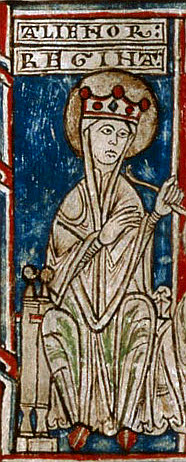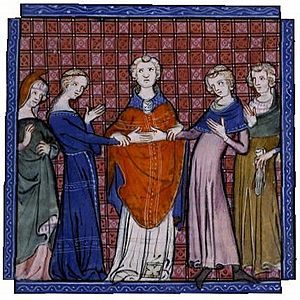Eleanor of England, Queen of Castile facts for kids
Quick facts for kids Eleanor of England |
|
|---|---|
 |
|
| Queen consort of Castile and Toledo | |
| Tenure | September 1170 – 5 October 1214 |
| Born | c. 1161 Domfront Castle, Normandy |
| Died | 31 October 1214 (aged 53) Burgos, Castile |
| Burial | Abbey of Santa Maria la Real de Huelgas, Burgos |
| Spouse | |
| Issue more... |
Berengaria I, Queen of Castile Urraca, Queen of Portugal Blanche, Queen of France Eleanor, Queen of Aragon Henry I, King of Castile |
| House | Plantagenet / Angevin |
| Father | Henry II, King of England |
| Mother | Eleanor, Duchess of Aquitaine |
Eleanor of England (Spanish: Leonor; around 1161 – 31 October 1214) was a powerful queen. She was the wife of Alfonso VIII of Castile, making her the Queen of Castile and Toledo. Eleanor was the sixth child and second daughter of King Henry II of England and Eleanor of Aquitaine. After her husband died, she briefly served as the ruler (Regent) of Castile for her young son, Henry I, until her own death in 1214.
Contents
Early Life and Family
Eleanor was born in Domfront Castle in Normandy around 1161. Her parents were King Henry II of England and Eleanor, Duchess of Aquitaine. She had many famous siblings! Her full siblings included King Richard I (also known as Richard the Lionheart) and King John. She also had half-sisters, Marie and Alix, from her mother's first marriage.
Becoming Queen of Castile

In 1170, when Eleanor was only nine years old, she married King Alfonso VIII of Castile in Burgos. This marriage was arranged by her parents for important political reasons. It helped secure the border of Aquitaine (a region her mother ruled) near the Pyrenees mountains. For Alfonso, it meant gaining an ally in his conflicts with the King of Navarre.
Eleanor became a very influential queen. Her marriage agreement gave her direct control over many lands, towns, and castles in Castile. This made her almost as powerful as her husband, King Alfonso. He even stated in his will that she should rule alongside their son if he died.
Eleanor was also a big supporter of religious places. In 1179, she helped maintain a special shrine for Thomas Becket in the cathedral of Toledo. She also founded and supported the Abbey of Santa María la Real de Las Huelgas. This abbey became a significant place for her family, serving as a refuge and a burial site for many generations.
Eleanor as Regent
When King Alfonso VIII died, Eleanor was heartbroken. She was so sad that her eldest daughter, Berengaria, had to take her place at the funeral. According to her husband's will, Eleanor became the regent of Castile. This meant she would rule the kingdom because her son, Henry I, was still too young.
However, Eleanor's health was not good. She left most of the important decisions to her daughter, Berengaria. Eleanor died only twenty-six days after her husband, on 31 October 1214. She was buried next to him at the Abbey of Santa María la Real de Las Huelgas.
Children of Eleanor and Alfonso VIII
Eleanor and Alfonso VIII had many children. Here are some of their most well-known children:
| Name | Birth | Death | Notes |
|---|---|---|---|
| Berengaria | 1180 | 1246 | She was Queen of Castile in her own right. She later gave up her throne for her son, Ferdinand III of Castile, who reunited the kingdoms of Castile and León. |
| Urraca | 1186/1187 | 1220 | She married Afonso II of Portugal and became the Queen of Portugal. |
| Blanche | 1188 | 1252 | She married Louis VIII of France and became the Queen of France. She also served as a powerful regent for her son, King Louis IX. |
| Ferdinand | 1189 | 1211 | He was the heir to the throne but sadly died before his father. |
| Eleanor | 1200 | 1244 | She married King James I of Aragon. |
| Henry | 1204 | 1217 | He became King of Castile after his father's death. He was very young and died when a tile fell on his head. |
Later Mentions
After her death, Eleanor was remembered for her beauty and royal presence by poets. Her great-grandson, King Alfonso X, described her as "noble and much loved."
See also
 In Spanish: Leonor Plantagenet para niños
In Spanish: Leonor Plantagenet para niños
|

